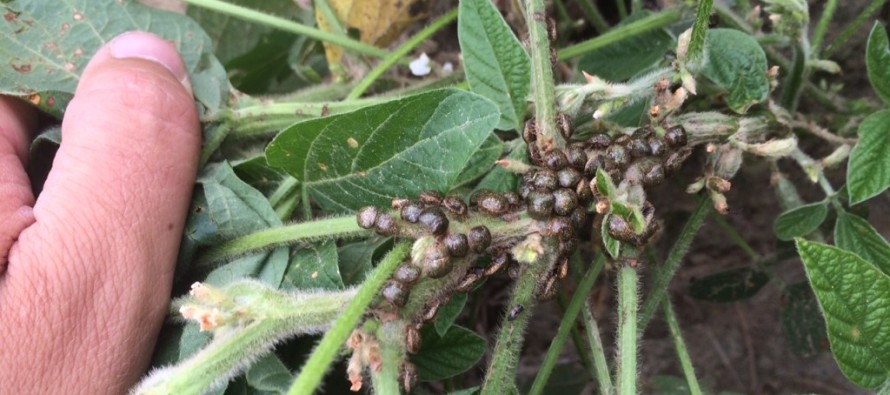Kudzu Bugs in Mississippi Soybeans

Related Articles
- 2010 Soybean And Corn Variety Trial Data 3
- Mississippi Cotton Insect Situation of 2010: A Look Back 3
- Rice Insecticidal Seed Treatment Recommendations for Mississippi in 2011 0
Latest Tweets
Over the last couple weeks we have begun to get numerous calls about kudzu bugs infesting soybeans. Call are coming from all over the state. We no longer keep up with county level infestations but its safe to say they are pretty much established now in every county in Mississippi. As populations continue to grow, movement from kudzu to soybeans has become common. Most of the higher infestations in soybeans at this time do appear to be in the relative proximity to kudzu. Although we are finding numerous adults in soybeans in some places, the kudzu we have been looking at still has very high numbers of late instar nymphs. This indicates that the migration from kudzu will continue for a while. It is important to remember that kudzu bugs do not feed on the pods. They feed on stems and petioles and cause yield loss bug sucking the vigor of the plant down. With that said, it takes A LOT to cause a yield loss. Because they are very visible it scares a lot of folks to see them in the crop. Most of the high levels of adults we are seeing are restricted to field edges. Often you can get away with a border treatment on field edges but keep in mind adults may still migrate in for several more weeks even after sprays.
Research at North Carolina State by Dominic Reisig and his group indicated that it took on average 42 days from egg to adult. We will likely continue to see movement into soybeans from now into August as we did last year.
Below is some information we posted last year (modified) concerning thresholds and products to treat with.
What to do? Fortunately we have a lot of research from our colleagues in the southeast to draw from but it will be critical to determine what tweaks we will have to make in our production system here in Mississippi because it is much different. We are already experiencing a few things that they have not encountered in the southeast but we do have an active research project funded by the Mississippi Soybean Promotion Board looking at kudzu bugs in MS soybeans with new M.S. student Bill McRight. For now we have simply adopted their threshold of 5 bugs/plant during the vegetative stages and 1 nymph/sweep during the reproductive stages.
One thing that is much different here than in the southeast is the fact that we have soybeans in the reproductive stages in some areas when the overwintering bugs moved into soybeans from overwintering because we plant much earlier than the Southeast.
Remember that kudzu bugs have piercing/sucking mouthparts so they will not make holes in the leaves. They feed on the stems and petioles of the plant. Remember, do not feed on the fruit like stink bugs so it takes high numbers to be a problem. Don’t get alarmed when you start finding 20 or 3o adults per 25 sweeps. The likelihood of low numbers causing any yield loss is extremely low. Hopefully by utilizing the nymph threshold, we can minimize the number of treatments required to control this pest. When nymphs show up, it is a sign the adult migration is over and one spray should be sufficient.
The figure below is a compilation of trials from 2010-2012 from the entomologist in the Southeast that shows average efficacy for various products on Kudzu Bugs. It appears that several things work well but products containing bifenthrin continue to float to the top.
Click to Enlarge
The following presentation “Observations and Biology of Kudzu Bugs and Their Management in Southeastern Soybeans” provides some fantastic photos and information from the University of Georgia and Clemson University.







Let me tell You a sad story ! There are no comments yet, but You can be first one to comment this article.
Write a comment